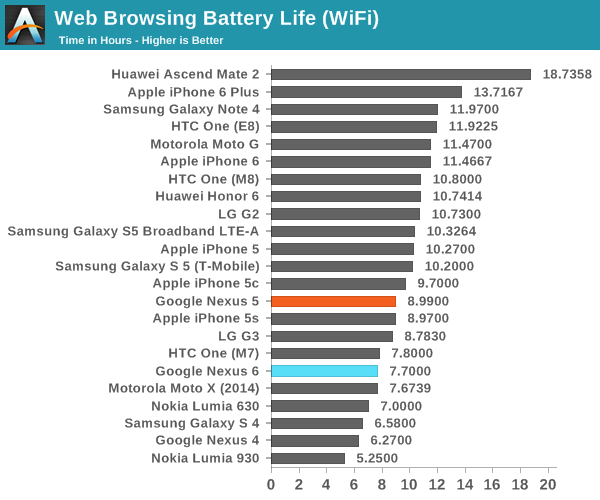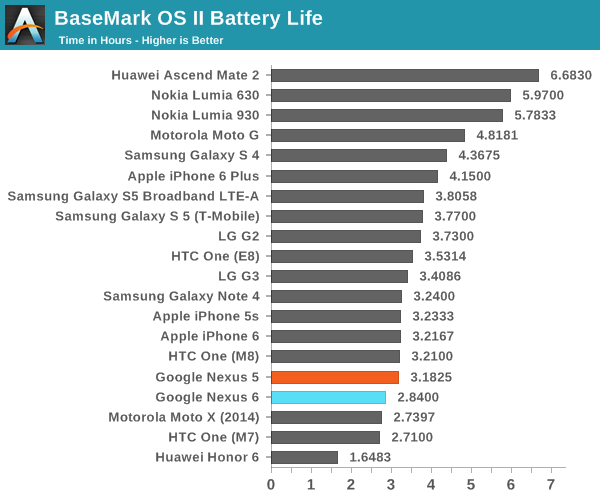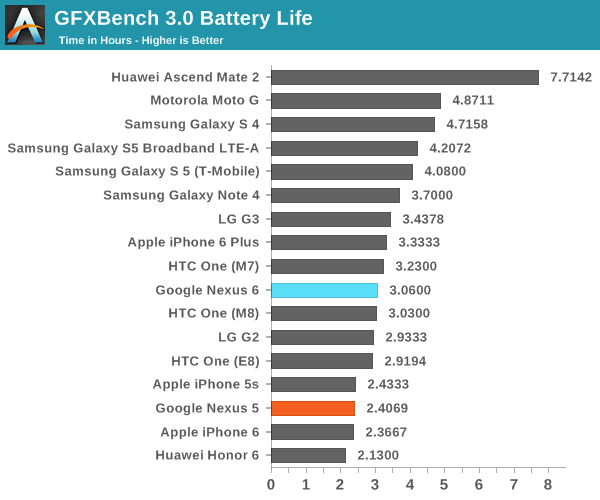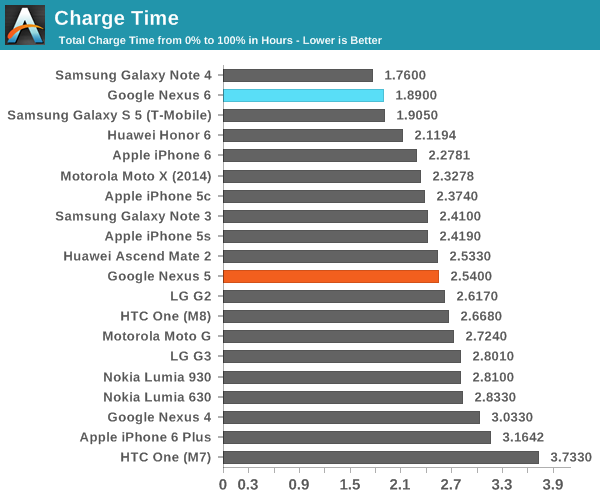The Nexus 6 Review
by Brandon Chester on November 12, 2014 1:00 PM ESTBattery Life
Battery life is one of the most important aspects of a smartphone, as it effectively determines how long you'll be able to use all of its other features. In order to get a comprehensive understanding of battery life on the Nexus 6 we run a variety of tests that attempt to stress different parts of the device in order to determine the battery performance in different conditions. Most important is that all displays are calibrated to 200 nits to avoid penalizing certain phones for having brighter displays than others.

The first test is our WiFi web browsing test which loads a set of web pages in a loop with pauses to avoid penalizing phones with faster SoCs than others. In this test we see that the Nexus 6 does perform somewhat poorly. Compared to Samsung's Galaxy Note 4 which has essentially the same specifications on paper, the Nexus 6 lasts 4.27 hours shorter. It is likely that this can be attributed to the display, which may not be as efficient as the latest and greatest AMOLED panel used in the Note 4.
At this point we would usually post results for web browsing battery life on LTE. However, I've had difficulty locating a place to perform testing with a reliable cellular signal, and I didn't wish to put the Nexus 6 at an unfair disadvantage by performing the test with poor reception. Because of this, I was unable to obtain LTE battery life results for the Nexus 6, but given the platform it's likely that battery life is around 7.25 to 7.5 hours on our LTE web test.


In our more SoC-bound BaseMark OS II battery test we see that the Nexus 6 doesn't last quite as long as the Note 4. This is again likely due to a higher display power consumption on the Nexus 6, as both devices share the same SoC fabricated on the same process. However, we see that the battery score is a bit higher, likely due to a higher average CPU frequency afforded by a larger heat dissipation area to reduce throttling.


With GFXBench which is a more GPU focused test, we see similar results to our BaseMark OS II test. The Nexus 6 doesn't last quite as long as the Galaxy Note 4, with slightly more than 3 hours of usage compared to the Note 4 with 3.7 hours of usage. The gap definitely closes between the two here, but unfortunately it seems that the display continues to hurt overall battery life. The fact that the web browsing result is so close here suggests that Motorola is continuing to target "24 hours of mixed usage", so if one does fit their usage model they shouldn't have isssues lasting a day on battery. I can't help but think that a good LCD would get them much more battery life for the same battery size, but it should be usable here even if it's behind the competition.
Charge Time
The charge time of a smartphone is also very important. While having a long battery life means that a device can be used for longer, if it also requires a very long charging time it may be that the device is less frequently able to be fully charged and thus unable to actually reach its potential battery life. Charge time can also be an important factor in time-constrained situations such as topping up your battery before a flight. In order to test battery life we deplete the device's battery charge to 0, and then measure the duration that the device is plugged in until it reaches a power draw that indicates it is completely charged.

The Nexus 6 includes Motorola's Turbo Charger which can output 9V at 1.6A or 12V at 1.2A to Qualcomm Quick Charge 2.0 compatible devices. As you can see above, this leads to an exceptionally low charge time of 1.89 hours. I'm very glad that Google and Motorola decided to include the Turbo Charger instead of a typical 5W adapter. Something I would like to note is that my Turbo Charger did exhibit very noticeable coil whine, although this may have simply been an issue specific to my unit.










136 Comments
View All Comments
Hrel - Wednesday, November 19, 2014 - link
4.95” 1080p IPS LCD 5.96” 1440p Super AMOLEDRight so, Nexus 5 it is then! Wish it didn't have less RAM and worse cameras. :(
Acreo Aeneas - Sunday, November 23, 2014 - link
Brandon,Does the recent news about Google's default encryption setting for the Nexus 6 be a significant drain on the battery in your tests? Perhaps we might see a better battery life turnout if encryption was disabled?
anonymousmonkey54 - Saturday, November 29, 2014 - link
I found lots of posts saying that battery life and performance dramatically improved when the phone was decrypted. You guys should probably run the benchmarks again with the phone decrypted to see if the lag is caused by the encryption.p51d007 - Tuesday, December 2, 2014 - link
No thanks WAY too expensive. 1080p screens, 80x processors, ois cameras (can't anyone hold one still???), OVERKILL. I use to think you had to have the latest/greatest hardware & OS to have a good user experience, but not after buying a 6.1" chinese mid range device 3 months ago. One of my coworkers got one yesterday, it's nice, fast and responsive. I set the display on mid range on his device & my cheap 720p screen, brought up the same pages, launched the same apps and I couldn't tell a difference, other than the apps on his might have launched .2 seconds quicker. Screen display looked just as good on my device as his did at a NORMAL viewing distance. I don't put my eyeball right up to the screen, but a normal distance of almost 1/2 arms length. My device still has 4.3, but the OS/hardware/screen apparently has been tweaked by the manufacturer, and it is flat out fast. I take a lot of work related photos (mostly close up), but have taken a lot of photos when I didn't have my dSLR with me, and IF YOU HOLD A CAMERA STILL, it takes awesome photos. Hey, it's your money, spend it how you want, but I just don't get laying out that much for a device, that the apps don't utilize the hardware to its fullest potential. Most people surf, send text/instagram/twitter/facebook, maybe watch a video, listen to music. Most devices within the last few years, with a LOT less specs, can do that. Most people only run 1 app at a time, close it, open another. I'm talking generally, not "power" users who on larger screens may run 2 apps at a time. Seems like a "slight" bump in performance, just for a little polished metal/plastic, higher density (not really needed) screen, larger battery and OIS in the camera. Unless the price comes WAY down to close to the past Nexus line, I don't see it selling outright, but through carriers, who will of course, add bloat, and try to lock out features. Google started something with the lower price Nexus, and people have become accustomed to that price, not this SKY HIGH price.Milkman128 - Friday, December 5, 2014 - link
Lock screen notifications! only 5 years late to that game.moyanous - Wednesday, April 8, 2015 - link
If you wish to view photos in accurate rather than the over-saturated factory default colors then have a look at this app "Calibrated Photo Viewer"https://play.google.com/store/apps/details?id=com....
It's a gallery viewer with pre-calibrated color and gamma corrections for the Nexus 6 (and other devices).
Both sRGB and Adobe RGB color spaces are supported by the app.